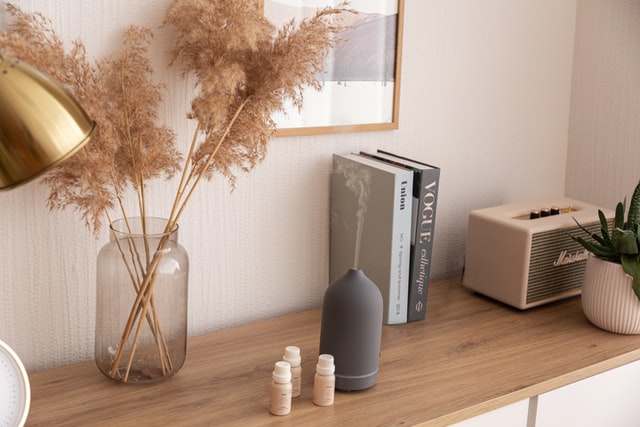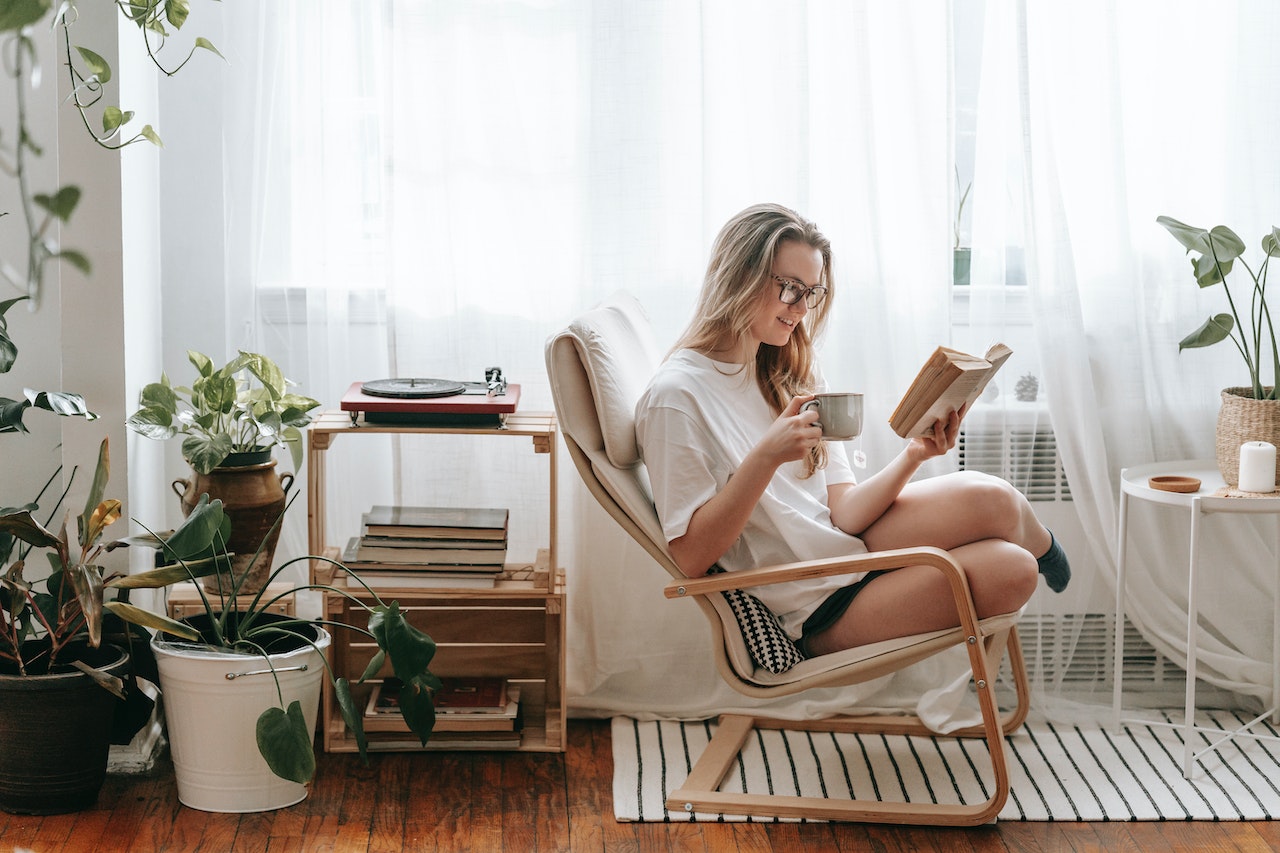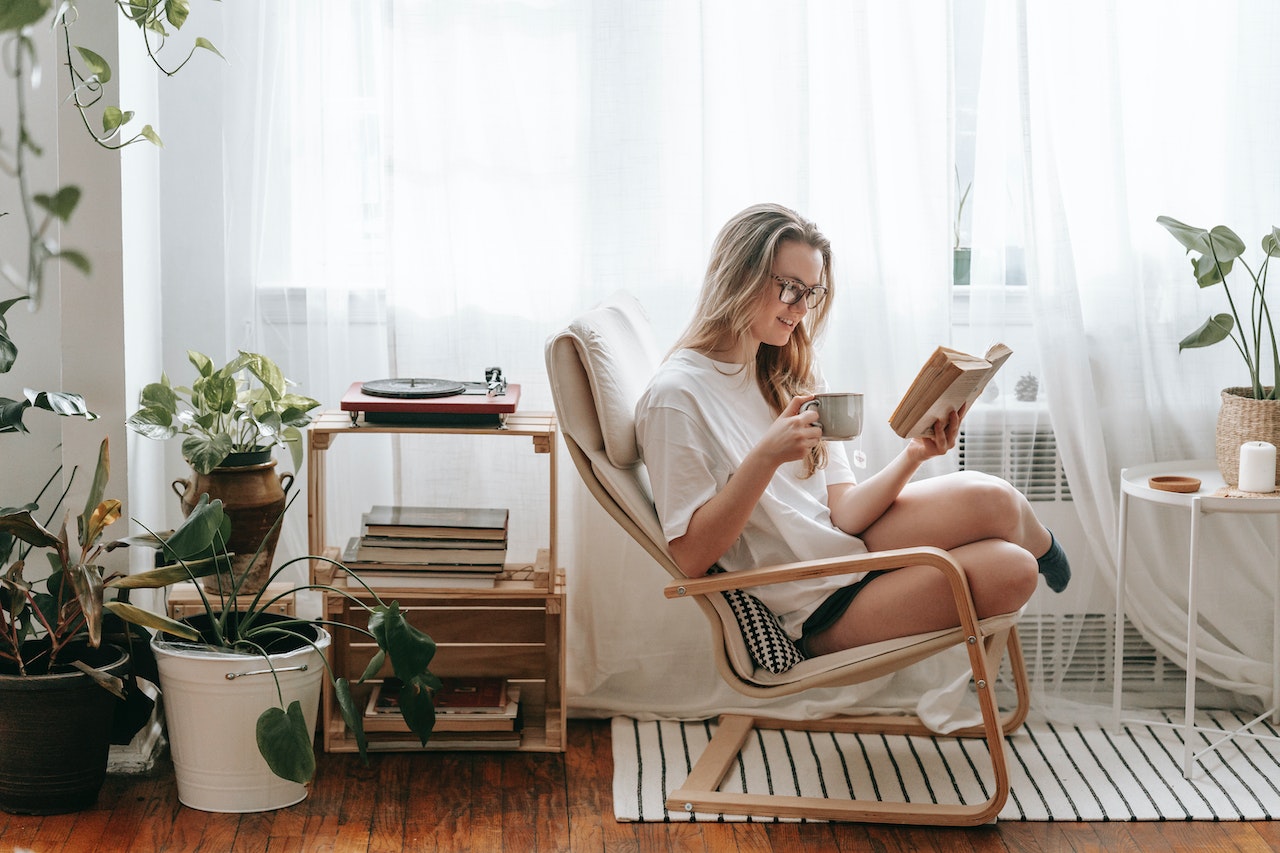Your home environment plays a vital role in your physical and mental wellbeing. If you’re suffering from stress or anxiety, it’s crucial to make sure that your home is a place that promotes feelings of positivity and calm. People who work from home may suffer from mental wellbeing issues.
Conditions like burnout have become more common in recent years. Taking care of our mental health in the workplace has become a challenge, especially for those working from home. However, these issues can affect anyone from every age group and background. Fortunately, there are things you can do in order to simplify your life and improve your home, which will, in turn, promote a greater sense of happiness. This guide has some easy, helpful tips that will encourage and inspire you to start taking action to make your home a space that’s welcoming and optimized for better mental wellbeing.
Having a clean, organized home can be beneficial for your health. Studies show that being surrounded by clutter can negatively affect your mental health in many ways. Thankfully, there are several things you can do to optimize your space to improve your sense of emotional wellbeing. With the proper arrangements, layout, and organization, you can free your mind and enjoy improved wellbeing at home.
Navigate this article:
- Optimize Your Home for Better Mental Wellbeing
• Declutter, Organize, and Clean – In That Order
• The Importance of Having the Correct Layout - Customize Your Home for Better Mental Wellbeing
• Color Psychology
• Let the Light In - Modernize Your Home for Better Mental Wellbeing
• Smart Gadgets for Wellbeing
• Activities to Try at Home
Optimize Your Home for Better Mental Wellbeing
Declutter, Organize, and Clean – In That Order
It’s essential to develop the best strategy for decluttering your home. Even if you have limited time, try to tackle just one room at a time. You can do this just once per week, and before you know it, your home will be clean and clutter-free. If you have kids at home, use storage systems like bins with labels and shelving units to keep books and toys organized. Come up with a day of decluttering and make it fun so that your kids can get involved.
- Separate items into piles that you want to keep, sell, and give away, making it easier to get the things you want to keep organized later.
- Host a yard sale to sell items you no longer want or need. Look for some local nonprofit organizations where you can donate your items and put them to good use.
- Use labels to help you separate your belongings by type. Place everything in fabric or plastic bins, so they stay in one designated area.
- When it’s easy to find what you need, you’ll notice an improvement in your stress and emotional wellbeing. Schedule one day a week to declutter your home room-by-room until you finish.
- After you’ve decluttered and organized, it’s time to do some cleaning. All-purpose cleaning sprays, sponges or microfiber cloths, and disinfectant products are all must-haves to keep a clean space.
- Invest in a quality vacuum cleaner to keep carpets and rugs nice and clean. Dust your furniture and clean your windows weekly to maintain a clean, healthy home.
- Struggling with your mental wellbeing can cause you to put your household chores on hold. Try washing your dishes after eating instead of letting them sit in the sink and putting away tools after finishing a project.
- Once you finish decluttering your space, it will be easier to declutter your mind.
From furniture and garments to books and different knickknacks, we collect a ton of things as we age. By the time we arrive at retirement age, our homes are pressed loaded with things – some that are as still meaningful, however, a lot more are just clutter. Cleaning up can really change your life and set you straight every day of the week. When you’ve cleaned up, you can zero in on downsizing to a home that accommodates your way of life.
The Importance of Having the Correct Layout
Having an open space is proven to be more beneficial for your mental wellbeing. By doing some rearranging, your home will make you feel much calmer and more relaxed. Draw a few layout ideas on paper, then decide which furniture arrangement works best for you. If you’re more tech-savvy, use a home design app to help you preview your layout before you commit. Always make sure you have plenty of room to move around and won’t bump into furniture. A clear pathway to and from each room is vital to wellbeing at home.
Customize Your Home for Better Mental Wellbeing
Adding some touches of your personality will make your home feel more welcoming. You’ll also be much happier whenever you’re spending time at home. Here are some ways to customize your home and make it more mental health-focused and suitable for you.
Color Psychology
Room color can have a significant impact on our overall wellbeing. The colors you’re surrounded with in your home can either add to your stress or help you conquer it. For this reason, it’s essential to think twice before painting your walls and decorating your living space.
Different colors have been found to evoke specific psychological responses and can be used to create certain moods or atmospheres. Applying color psychology at home involves selecting and using colors strategically to achieve desired effects in different rooms or areas. It is demonstrated that colors can influence a child’s thinking or responding patterns, playing a significant role in their growth and development.
- Blue: Associated with calmness, serenity, and relaxation. It can be a great choice for bedrooms or areas where you want to promote rest and tranquility. Consider using soft blue shades on walls, bedding, or accent pieces.
- Yellow: Vibrant and cheerful color that is known to evoke feelings of happiness and energy. It can work well in spaces where you want to create a lively and positive atmosphere, such as kitchens or dining areas. Incorporate yellow through paint, accessories, or artwork.
- Green: Associated with nature, balance, and renewal. It can promote a sense of harmony and has a calming effect. Use shades of green in areas where you want to create a peaceful and soothing ambiance, such as living rooms or home offices.
- Red: Powerful and intense color that can evoke strong emotions. It is often associated with passion, energy, and stimulation. However, too much red can be overwhelming, so it’s best used as an accent color in areas where you want to create a sense of excitement, such as a dining room or an exercise space.
- Purple: Associated with luxury, creativity, and spirituality. It can create a sense of opulence and sophistication. Consider using shades of purple in bedrooms or creative spaces to inspire imagination and relaxation.
- Neutral colors: Colors like white, beige, and gray are often used as neutral tones. They can create a sense of calmness, simplicity, and neutrality. These colors work well as a base or background in any room and can be complemented by accent colors to add vibrancy or contrast.
Here are some ways in which room color can affect our wellbeing:
Mood and emotions: Different colors have the ability to evoke specific moods and emotions. Warm colors like red, orange, and yellow can create a sense of energy and warmth, while cool colors like blue and green can promote calmness and relaxation. Bright and vibrant colors can uplift our mood and create a sense of happiness, while muted or pastel shades can have a soothing effect.
Perception of space: Colors can influence how we perceive the size and layout of a room. Lighter colors tend to make a space feel more open and spacious, while darker colors can make a room feel smaller and cozier. This can impact our comfort level and sense of freedom within a space.
Concentration and productivity: The right color choice can enhance our focus, concentration, and productivity. For tasks that require mental alertness, such as a home office or study area, cooler colors like blue and green can promote a more focused and productive mindset. However, it’s important to strike a balance as overly cool colors may lead to a lack of energy or motivation.
Sleep quality: The color of a bedroom can greatly influence our sleep quality. Soft and soothing colors like light blue, lavender, or pastel shades can create a calming environment conducive to relaxation and restful sleep. Avoid using bright or stimulating colors in the bedroom, as they may hinder relaxation and disrupt sleep patterns.
Personal preferences: It’s crucial to consider personal preferences when selecting room colors. Individual experiences, cultural background, and personal associations with colors can vary, resulting in different emotional and psychological responses to specific colors. Choose colors that resonate with you and create a positive environment that supports your wellbeing.
Here are some tips for applying color therapy to your home:
- Design an accent wall featuring a fun, vibrant color to lift your mood. You can also add some playfully patterned wallpaper for a fun pop.
- Create a colorful gallery wall filled with a variety of artwork and framed photos. Use different-colored frames for a fun visual effect.
- Use pops of color in your home by adding décor that helps wellbeing like colorful throw pillows, area rugs, baskets, or a few decorative sculptures.
- Try some LED strip lights or lightbulbs that change color or look for mood lights you can program via a Bluetooth app to set the tone.
Let the Light In
Natural light has profound positive impacts on both mental and physical wellbeing. Here are some ways in which natural lighting can impact us:
- Mood and emotions: Exposure to natural light has been linked to improved mood and increased levels of happiness. Sunlight stimulates the production of serotonin, a neurotransmitter that helps regulate mood, sleep, and overall wellbeing. Lack of natural light, on the other hand, can contribute to feelings of fatigue, low energy, and even seasonal affective disorder (SAD). A sun lamp or light therapy box can help improve insomnia and anxiety.
- Sleep regulation: Natural light exposure helps regulate our circadian rhythm, the internal body clock that influences our sleep-wake cycle. Exposure to natural light during the day, especially in the morning, helps signal to our bodies that it’s time to be awake and alert. It can improve the quality and duration of our sleep, leading to better overall wellbeing.
- Vitamin D production: Sunlight is the primary source of vitamin D, which plays a crucial role in our bone health, immune system function, and overall wellbeing. When our skin is exposed to sunlight, it synthesizes vitamin D, which is essential for various bodily functions. Insufficient sunlight exposure can lead to vitamin D deficiency and associated health issues.
- Cognitive performance: Natural lighting has been shown to enhance cognitive performance, focus, and productivity. Adequate daylight in work or study areas can positively impact our concentration, alertness, and overall cognitive function. It can reduce eye strain and fatigue, resulting in improved work or study efficiency.
- Visual comfort: Natural light provides a more balanced and visually comfortable environment compared to artificial lighting. It allows for better color perception, reduces eye strain, and creates a more pleasant and inviting atmosphere. Natural lighting can also enhance our connection to the outside world, improving our sense of openness and connection to nature.
- Health benefits: Natural light exposure has been associated with various health benefits, including improved immune function, reduced risk of certain medical conditions (such as myopia in children), and faster recovery times for patients in hospitals. Access to natural light and views of nature have been shown to positively impact patient wellbeing and healing.
To maximize the benefits of lighting in your home or workspace, consider the following home renovation projects:
Install skylights or roof windows: They can be installed in various areas of your home, such as living rooms, kitchens, or hallways. Skylights come in different shapes and sizes, allowing you to customize the amount of light you want to bring in.
Add windows or expand existing ones: If certain rooms in your home lack sufficient natural light, you can consider adding new windows or enlarging existing ones. This can involve cutting through walls to create new window openings or extending windows vertically or horizontally. It’s important to consult with a professional to ensure structural integrity and proper installation.
Use glass doors: Replace solid exterior doors with glass doors or install French doors to allow natural light to flow into adjoining rooms. This works particularly well for rooms adjacent to the outdoors or spaces with access to a patio or garden.
Create interior light wells: Light wells are vertical shafts or courtyards open to the sky. By introducing light wells within your home, you can bring natural light to lower levels or interior areas that may not have direct access to windows. This is commonly done in basements or central areas of larger homes.
Remove obstacles: Identify any elements in your home blocking natural light, such as overgrown vegetation, awnings, or structures outside windows. By removing these obstacles, you can maximize the sunlight entering your home.
Use light-reflective surfaces: Incorporate light-reflective surfaces and materials in your home’s interior design. Mirrors, glass, and lighter-colored walls, ceilings, and floors can help bounce and distribute natural light throughout the space, making it feel brighter and more open.
Consider open floor plans: If feasible, consider opening up interior walls to create more open floor plans. This allows natural light to flow more freely between spaces, increasing the overall brightness and connectedness of the home.
Before undertaking any renovation projects, it’s advisable to consult with professionals such as architects, contractors, or designers to assess the feasibility and potential impact on your home’s structure and aesthetics. Also, consult your specific home insurance policy and contact your insurance provider to discuss any planned renovations before starting the project. They can guide how the renovations may impact your coverage and help you make any necessary adjustments to your policy.
Modernize Your Home for Better Mental Wellbeing

Look for modern tech and products to improve your wellbeing, like noise machines and apps that help with sleep or meditation. Technology can help with mental wellness and make spending time at home pleasant rather than a stressful time. Here are some home wellness technology gadgets to consider and activities you can try at home to encourage healthy mental wellbeing.
Smart Gadgets for Wellbeing
Smart gadgets can play a role in improving our wellbeing by providing convenience, monitoring health, promoting relaxation, and enhancing overall quality of life. Consider using some of these handy wellness technology gadgets at home:
- Fitness and health tracking: Smart wearables like fitness trackers or smartwatches can monitor your physical activity, heart rate, sleep patterns, and other health metrics. They provide insights into your daily habits and encourage you to maintain an active and healthy lifestyle. These gadgets can serve as motivators to achieve fitness goals and track progress over time.
- Smart home lighting and sleep aids: Smart lighting systems can simulate natural lighting patterns, helping regulate your circadian rhythm and improve sleep quality. Some devices offer features like color temperature adjustment, which can promote relaxation and a calming environment in the evening. Smart sleep aids, such as white noise machines or smart pillows, can also create a more soothing sleep environment.
- Meditation and relaxation: There are various smart gadgets and apps designed to assist with meditation and relaxation. These can include guided meditation apps, smart speakers with built-in relaxation features, or wearable devices that monitor your stress levels and prompt mindfulness exercises. These gadgets can help reduce stress, promote mental wellbeing, and improve focus and mindfulness.
- Smart home assistants: Voice-activated smart home assistants, such as Amazon Alexa or Google Assistant, can provide convenience and assistance in managing daily tasks. They can set reminders, answer questions, play music or podcasts, and control various smart devices in your home. By simplifying tasks and reducing mental load, these gadgets can contribute to overall wellbeing.
- Home security and safety: Smart security systems with features like video surveillance, motion sensors, and remote monitoring provide peace of mind and a sense of security. Knowing that your home is protected can reduce stress and promote wellbeing, especially when you’re away from home. Smart fire alarms and carbon monoxide detectors can also enhance safety and potentially save lives.
- Personalized environment control: Smart thermostats and air purifiers allow you to optimize the indoor environment for comfort and health. They can adjust temperature, humidity levels, and air quality based on your preferences and needs, creating a more comfortable and healthier living space.
- Essential oil diffusers help provide aromatherapy that can create a calming environment. Choose oils like lavender to fill your home with a soft, relaxing fragrance.
- A variety of massaging devices are available to help with sore, tired, or aching muscles. Use a neck, foot, or back massager to help you relax after a long day.
- Install a water purifier to ensure you drink the cleanest, healthiest water possible. Drink several glasses of water daily to improve your physical and mental wellbeing.
Activities to Try at Home
Try these easy activities at home to improve mental wellbeing.
- Set up a self-care room or use a corner of a room in your home to have a calm, quiet place to unwind and relax. A reading nook or yoga room are excellent examples.
- Add houseplants to your home to improve air quality and create a calming vibe. Taking care of your plants could help reduce anxiety. Look for low-maintenance plants if you struggle with constant upkeep.
- Listen to soothing music to help improve wellbeing at home. You can also learn to play a new instrument like the piano or violin. Music has incredibly impactful healing abilities on the body and mind.
- Switching off and learning a new hobby like sewing, painting, or other arts and crafts you’re interested in. Hobbies are a great way to help you focus on something you really enjoy, and they can also help you forget your cares and stresses.
Keep all of these tips in mind to help you improve your mental wellbeing at home. With a few simple changes, you can transform your home and turn it into a place that will improve your mental health and wellness.




